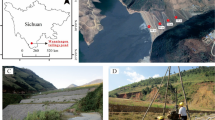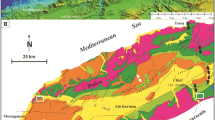Abstract
The assumption that the composition of continental input can be characterized from crustal rock types is the prerequisite for the application of the molybdenum (Mo) isotopic composition as an agent to determine variations in the redox state of the paleo-oceans. The Mo isotopes’ behavior in the weathered profile of basalt and granite had been studied in pervious works (Pearce et al., 2010, Voegelin et al., 2012 and Wang et al., 2018). However, the Mo isotopes’ behavior in the weathered profile of carbonate rock is unknown. In this work, the Mo concentration and Mo isotopic composition in a weathered profile from Guizhou province, China, are investigated for the first time to understand the behavior of Mo isotopes during carbonate rock chemical weathering. The profile is developed on Early Triassic dolomite. According to the field observation and element ratios, the weathered profile is divided into intensely weathered zone (IWZ), weekly weathered zone (WWZ) and fresh bedrock. The clear correlation between Hf and Zr concentration suggests that the dolomite is the parental material for the terra rossa. The τMo of weather soil ranging from ‒1.37 to –0.14 indicates the significant loose of Mo. The δ98Mo of the soil varies from –0.66 to 0.12‰, markedly lighter than the fresh bedrocks (1.82 to 1.97‰). The difference between soils and fresh bedrocks in δ98Mo suggests that Mo isotopes are fractionated during carbonate rock chemical weathering and heavy Mo isotopes are preferentially released, similar to the weathered profile of basalt and granite. According to the coupling relationship between Mo/Al2O3 and δ98Mo, the weathered model of dolomite was established: (1) the carbonate component is firstly dissolved, releasing most Mo with heavy Mo isotope composition. (2) The detrital component then is weathered to form secondary minerals, which adsorb the Mo from weathering fluid. Thus, the Mo/Al2O3 and δ98Mo of samples from IWZ are greater than that of WWZ.





Similar content being viewed by others
REFERENCES
A. D. Anbar, “Molybdenum stable isotopes: observations, interpretations, and directions,” In Geochemistry of Non-Traditional Stable Isotopes, Rev. Mineral. Geochem. 55 (1), 429–454 (2004).
C. Archer and D. Vance, “The isotopic signature of the global riverine molybdenum flux and anoxia in the ancient oceans,” Nat. Geosci. 1, 597–600 (2008).
G. Arnold, A. Anbar, J. Barling, and T. Lyons, “Molybdenum isotope evidence for widespread anoxia in mid-Proterozoic oceans,” Science 304, 87–90 (2004).
D. Asael, F. L. Tissot, C. T. Reinhard, O. Rouxel, N. Dauphas, T. W. Lyons, E. Ponzevera, C. Liorzou, and S. Cheron, “Coupled molybdenum, iron and uranium stable isotopes as oceanic paleoredox proxies during the Paleoproterozoic Shunga Event,” Chem. Geol. 362,193–210 (2013).
D. Colodner, J. Edmond, and E. Boyle, “Rhenium in the Black Sea: comparison with molybdenum and uranium,” Geochim. Cosmochim. Acta, 131, 1–15 (1995).
A. J. Dickson, “A molybdenum-isotope perspective on Phanerozoic deoxygenation events,” Nature Geosci. 10, 721–726 (2017).
G. Faure, Principles of Isotope Geology, 2nd Ed. (John Wiley & Sons, New York, 1986).
J.-L. Feng, “Behavior of rare earth elements and yttrium in ferromanganese concretions, gibbsite spots, and the surrounding terra rossa over dolomite during chemical weathering,” Chem. Geol. 271, 112–132 (2010).
J.-L. Feng, “Trace elements in ferromanganese concretions, gibbsite spots, and the surrounding terra rossa overlying dolomite: their mobilization, redistribution and fractionation,” J. Geochem. Explor. 108, 99–111 (2011).
J.-L. Feng, L.-P. Zhu, and Z.-J. Cui, “Quartz features constrain the origin of terra rossa over dolomite on the Yunnan–Guizhou Plateau,” China. J. Asian Earth Sci. 36, 156–167 (2009).
J.-L. Feng, L.-L. Pei, X. Zhu, J.-T. Ju, and S.-P. Gao, “Absolute accumulation and isotope fractionation of Si and Fe during dolomite weathering and terra rossa formation,” Chem. Geol. 496, 43–56, (2019).
T. Goldberg, C. Archer, D. Vance, and S. W. Poulton, “Mo isotope fractionation during adsorption to Fe (oxyhydr) oxides,” Geochim Cosmochim Acta 73, 6502–6516 (2009).
T. Goldberg, S. W. Poulton, T. Wagner, S. F. Kolonic, and M. Rehkämper, “Molybdenum drawdown during Cretaceous Oceanic Anoxic Event 2,” Earth Planet. Sci. Lett. 440, 81–91(2016).
A. T. Greaney, R. L. Rudnick, S. J. Romaniello, A. C. Johnson, R. M. Gaschnig, and A. D. Anbar, “Molybdenum isotope fractionation in glacial diamictites tracks the onset of oxidative weathering of the continental crust,” Earth Planet. Sci. Lett. 534, 116083, (2020).
J. Li, X. R. Liang, L. F. Zhong, X. C. Wang, Z. Y. Ren, S. L. Sun, Z. F. Zhang, and J. F. Xu, “Measurement of the isotopic composition of molybdenum in geological samples by MC-ICP-MS using a novel chromatographic extraction technique,” Geostand. Geoanal. Res. 38, 345–354 (2014).
X. Lu, T. W. Dahl, W. Zheng, S. Wang, and B. Kendall, “Estimating ancient seawater isotope compositions and global ocean redox conditions by coupling the molybdenum and uranium isotope systems of euxinic organic-rich mudrocks,” Geochim. Cosmochim. Acta 290, 76–103 (2020).
D. Malinovsky, D. Hammarlund, B. Ilyashuk, O. Martinsson, and J. Gelting, “Variations in the isotopic composition of molybdenum in freshwater lake systems,” Chem. Geol. 236, 181–198 (2007).
D. S. Manta, M. Angelone, A. Bellanca, R. Neri, and M. Sprovieri, “Heavy metals in urban soils: a case study from the city of Palermo (Sicily), Italy,” Sci. Total Environ. 300, 229–243 (2002).
J. L. Morford and S. Emerson, “The geochemistry of redox sensitive trace metals in sediments,” Geochim. Cosmochim. Acta 63, 11–12(1999).
D. R. Muhs and J. R. Budahn, “Geochemical evidence for African dust and volcanic ash inputs to terra rossa soils on carbonate reef terraces northern Jamaica West Indies,” Quat. Int. 196, 13–35 (2009).
D. R. Muhs, J. Budahn, G. Skipp, J. M. Prospero, D. Patterson, and E. A. Bettis III, “Geochemical and mineralogical evidence for Sahara and Sahel dust additions to Quaternary soils on Lanzarote, eastern Canary Islands, Spain,” Terra Nova 22, 399–410 (2010).
H. W. Nesbitt, “Mobility and fractionation of rare earth elements during weathering of a granodiorite,” Nature 279, 206–210 (1979).
N. Neubert, A. Heri, A. R. Voegelin, T. F. Nagler, F. Schlunegger, and I. M. Villa, “The molybdenum isotopic composition in river water: constraints from small catchments,” Earth Planet Sci. Lett. 304, 180–190 (2011).
E. M. O’Sullivan, T. F. Nagler, and M. G. Babechuk, “Unusually heavy stable Mo isotope signatures of the Ottawa River: Causes and implications for global riverine Mo fluxes,” Chem. Geol. 568, 120039 (2021).
C. R. Pearce, K. W. Burton, P. A. E. P. von Strandmann, R. H. James, and S. R. Gíslason, “Molybdenum isotope behaviour accompanying weathering and riverine transport in a basaltic terrain,” Earth Planet. Sci. Lett. 295, 104–114 (2010).
R. L. Poulson, C. Siebert, J. McManus, and W. M. Berelson, “Authigenic molybdenum isotope signatures in marine sediments,” Geology 34 (8), 617–620 (2006).
L. Qi, J. Hu, and D. C. Gregoire, “Determination of trace elements in granites by inductively coupled plasma mass spectrometry,” Talanta 51, 507–513 (2000).
R. L. Rudnick and S. Gao, Composition of the Continental Crust, 2nd Ed. (Elsevier Ltd, 2013).
A. R. Voegelin, T. F. Nägler, T. Pettke, N. Neubert, M. Steinmann, O. Pourret, and I. M. Villa, “The impact of igneous bedrock weathering on the Mo isotopic composition of stream waters: Natural samples and laboratory experiments,” Geochim. Cosmochim. Acta 86,150–165 (2012).
Z. Wang, Z. Ma, G. Wei, T. Zeng, L. Li, L. Zhang, W. Deng, L. Xie, and Z. Liu, “Fe (hydro) oxide controls Mo isotope fractionation during the weathering of granite,” Geochim. Cosmochim. Acta 226, 1–17 (2018).
K. H. Wedepohl, “The composition of the continental crust,” Geochim. Cosmochim. Acta 59, 1217–1232 (1995).
M. Wille, O. Nebel, M. J. Van Kranendonk, R. Schoenberg, I. C. Kleinhanns, and M. J. Ellwood, “Mo–Cr isotope evidence for a reducing Archean atmosphere in 3.46–2.76 Ga black shales from the Pilbara, Western Australia,” Chem. Geol. 340, 68–76 (2013).
N. Xu, W. Braida, C. Christodoulatos, and J. P. Chen, “A review of molybdenum adsorption in soils/bed sediments: speciation, mechanism, and model applications,” Soil Sediment. Contam. 22, 912–929 (2013).
S. Yamasaki, A. Takeda, K. Nunohara, and N. Tsuchiya, “Red soils derived from limestone contain higher amounts of trace elements than those derived from various other parent materials,” Soil Sci. Plant Nutr. 59, 692–699 (2013).
P.-P. Zhao, J. Li, L. Zhang, Z.-B. Wang, D.-X. Kong, J.‑L. Ma, G.-J. Wei, and J.-F. Xu, “Molybdenum mass fractions and isotopic compositions of international geological reference materials,” Geostand. Geoanal. Res. 40, 217–226 (2015).
Q. Zhu, C. Yin, L. Tang, and J. Xu, “Content and distribution of trace elements in limestone soils of China,” Acta Pedol. Sin. 21, 58–69 (1984) [In Chinese with English abstract].
ACKNOWLEDGMENTS
This study is supported by the National Natural Science Foundation of China (NSFC; grants no. 41602343). We thank Jie Zhao (Guangzhou Institute of Geochemistry, Chinese Academy of Sciences) for his help with the sequential extraction procedure and analyses. The authors thank an anonymous reviewer and editor Alexei Buikin for their insightful suggestions.
Author information
Authors and Affiliations
Corresponding author
Ethics declarations
The authors declare that they have no conflicts of interest.
Rights and permissions
About this article
Cite this article
Yi Xiao, Xu, S., Guo, T. et al. Molybdenum Isotopes Behavior in the Dolomite-Terra Rossa Weathering System. Geochem. Int. 60, 589–595 (2022). https://doi.org/10.1134/S0016702922060106
Received:
Revised:
Accepted:
Published:
Issue Date:
DOI: https://doi.org/10.1134/S0016702922060106




